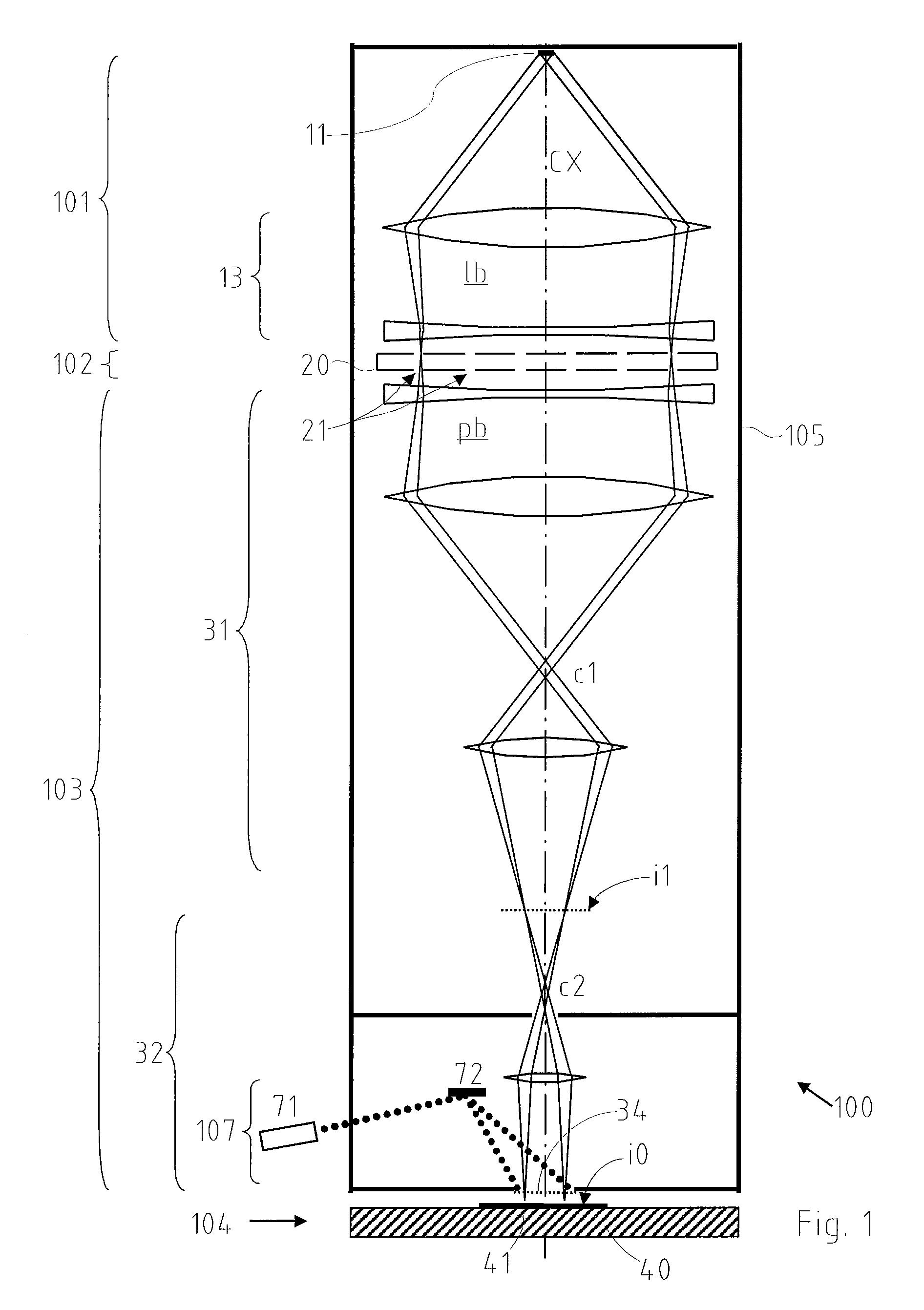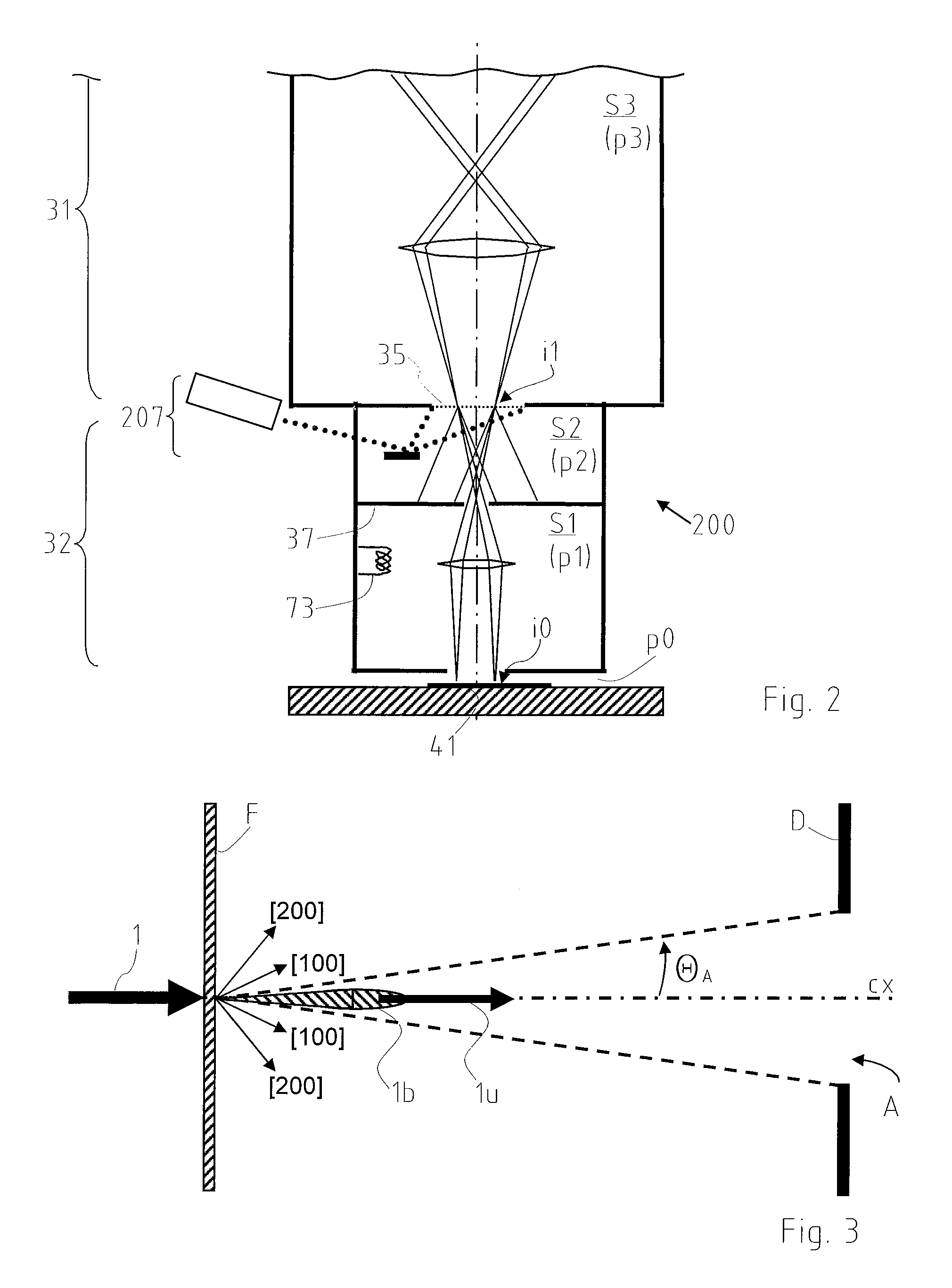Charged-particle exposure apparatus
a particle exposure and charge technology, applied in the field of particlebeam projection processing apparatus, can solve the problems of affecting local charging effects, pd system sensitive, and components of electron-optical systems that are likely to be contaminated by these particles, so as to avoid severe contamination and related risks, improve particle purity, and avoid the effect of severe contamination
- Summary
- Abstract
- Description
- Claims
- Application Information
AI Technical Summary
Benefits of technology
Problems solved by technology
Method used
Image
Examples
example 1
Foil Near to the Final Image
[0040]In the first embodiment which is shown in FIG. 1, a thin transmission foil 34 is placed between the last lens and the substrate, so as to bring the foil near to the position of the final image. Preferably, the distance between the foil 34 and the target 41 is very small, in the range of 200-500 μm. While elastic and / or inelastic scattering of some part of the electrons in the foil is inevitable, which will rise to an additional contribution to the blur of imaging (scattering blur), by virtue of the small distance between the foil and the substrate the scattering blur contribution is very small. Details of scattering are further discussed below. The inelastically scattered electrons have a reduced kinetic energy, but at the end of the column the field of the lenses is zero and therefore the trajectory of the electrons is not changed (there is not extra chromatic blur).
[0041]For a gap between the foil and substrate of Δl=200 μm, the allowed extra blur...
example 2
Foil at the Intermediate Image
[0046]FIG. 2 illustrates a second embodiment 200 of the invention, in which a part of the apparatus 200 is shown; elements of the apparatus 200 not described below are identical to those of the apparatus 100 of FIG. 1; same reference numbers refer to corresponding elements throughout.
[0047]As a consequence of the fact that the foil 35 is located at the position of the intermediate image i1, electrons which are scattered off their initial beam path are, nonetheless, focused at the final image plane i0 to the zero loss peak. Electrons which are scattered with a higher angle than 1.1 mrad have an increased spherical aberration, and these electrons are suitably blanked by a blanking diaphragm 37 situated after the foil 35.
[0048]The foil 35 divides the apparatus 200 into consecutive sections. In the first section S3, comprising the source 11, illuminating system 101, the PD device 102 and the part of the projection system until the intermediate image i1, is ...
example 3
Two Foils
[0065]FIG. 4 shows another embodiment of the invention, namely an apparatus 300 which comprises two foils 34′,35′ both at the intermediate image and in front of the target. Thus, the beneficial features of the foils can be combined. In particular, the foil 35′ at the intermediate image reduces the coulomb interaction at the last cross over and the total current through the coulomb can be increased (the coulomb interaction blur is the dominate blur), while the final foil 34′ prevents contamination of the optical components of the second stage 32 due to resist out gassing since the section S1 is not vacuum separated from the pressure p0 above the target 41.
Interlock Sensor and Safety Valve
[0066]As shown in FIGS. 5a and 5b, the foil may also be used as an interlock sensor to realize a safeguard device in conjunction with a safety valve. The safeguard device is used to rapidly trigger a safety valve in case of mechanical or electrical breakdown that causes a destruction of the ...
PUM
 Login to View More
Login to View More Abstract
Description
Claims
Application Information
 Login to View More
Login to View More - R&D
- Intellectual Property
- Life Sciences
- Materials
- Tech Scout
- Unparalleled Data Quality
- Higher Quality Content
- 60% Fewer Hallucinations
Browse by: Latest US Patents, China's latest patents, Technical Efficacy Thesaurus, Application Domain, Technology Topic, Popular Technical Reports.
© 2025 PatSnap. All rights reserved.Legal|Privacy policy|Modern Slavery Act Transparency Statement|Sitemap|About US| Contact US: help@patsnap.com



